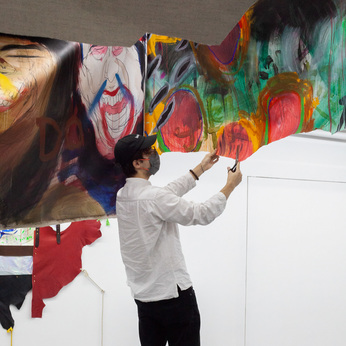-
From Current Issue
-
- Editor’s Letter Fire in the Heart
- Reviews I Gusti Ayu Kadek Murniasih
- Reviews 11th Seoul Mediacity Biennale: “One Escape at a Time”
- Dispatch Networked China
- One on One Monira Al Qadiri on Yukio Mishima
- Essays The rise of independent art spaces in pandemic-era Shanghai
- Features Tuan Andrew Nguyen
- Table of Contents
- Web Exclusives
- Archive
- Subscribe

R
E
V N
E
X
T
Installation view of DOUBLE FLY ART CENTER’s double love & flied currency (Double Fly Art Center 2020-Q-002), 2020, acrylic on canvas, colorless fluorescent pigment, fluorescent pigment, marker, UV light, audio, 146 × 292 cm, at “Double Fly Awkward Pay,” de Sarthe Gallery, Hong Kong, 2020–21. All images courtesy the artist and de Sarthe Gallery, Hong Kong.
The relationship between art and commerce is a storied affair. The current buzz surrounding new selling methods such as blockchains and platforms that offer shares of an artwork signify the increasing convergence of art and financial markets; the intrinsic qualities of these works run the risk of being overshadowed by their potential for monetary returns. The nine-artist collective Double Fly Art Center’s exhibition at Hong Kong’s de Sarthe Gallery, titled “Double Fly Awkward Pay,” is a timely, playful critique of such developments.
At first, the gallery appeared pitch-black. Nine similarly sized paintings mounted on the walls, re-purposed from a 33-meter-long acrylic mural executed by the group in 2015, constitute the double love & flied currency (2020) series. Arising from frustrations from not being able to sell the original work, the paintings were split from the mural, which featured colorful abstracted self-portraits and gestural symbols of clenched fists. However, these images are interrupted when the gallery lights are turned off intermittently and the work is shone under an ultraviolet light beam, revealing fluorescent pigments depicting banknotes issued by the group’s fictional Double Fly Awkward Pay Banking Branch. By directly equating the paintings to cash, Double Fly Art Center commodifies its own creations. A satirical criticism of this trend, calligraphic strokes in Chinese denoting the assigned currency amounts of each canvas are paired with motifs of phalluses as well as anuses and chrysanthemums—the latter a slang for the former in Chinese.
Imitating reality, the pieces in this series are not priced equally. Identically-sized (Double Fly Art Center 2020-Q-004) and (Double Fly Art Center 2020-Q-002), for example, both featuring similar motifs of clenched fists and figures, are priced at 170,000 and 120,000, respectively. Furthermore, these values are likened to “chrysanthemums” instead of dollars on the fictional banknote, highlighting the absurdity of the arbitrary pricing. This act of assigning a tangible value to a work thus reduces the significance of an artist’s talent, meaning that like money, the value of artworks may fluctuate over time based on external market forces.
The show’s center piece was the interactive installation Double Fly Cut Piece (2020), comprising a 11-meter-long acrylic-on-canvas suspended from the ceiling—the remaining stretch of the 2015 mural. Visitors can acquire a portion of Cut Piece, equivalent to the size of their own bodies, as long as they donate an amount corresponding to one of seven pairs of scissors of their choosing. The profits will go towards Double Fly Art Center’s fictional, Publicly Funded Police Department, a self-ridicule of the collective’s plea for funding to create works that in turn reject the commodification of art. Each tool is priced from HKD 1–3,000 in accordance to its degree of functionality, inferring the art market’s barriers to entry. For HKD 1, one is offered a pair of scissors with a dull, approximately one-centimeter-long blade, which barely allows one to reach the hanging sheet. However, the more one can afford, the more accessible the canvas becomes: for donations over HKD 3,000, one is offered a sharp pair of shears alongside a ladder. As more sections of Cut Piece are sold, the remaining canvas is left with awkwardly shaped ends, a visualization of the unequal market forces at play and their ability to reduce a work of art into mangled scraps.
Double Fly Art Center’s deliberate negation of its own artistic abilities for the sake of commodification is an effective performance that unpacks the convoluted relationship between contemporary art and market forces. It may be tempting to succumb to cynical conclusions about art’s trajectory, but the group’s self-deprecating practice is a reminder that artists continuously seek alternative methods to resist conventional expectations.
Martine Ma is an editorial intern at ArtAsiaPacific.
Double Fly Art Center’s “Double Fly Awkward Pay” was on view at de Sarthe Gallery, Hong Kong, from November 21, 2020, to February 20, 2021.
To read more of ArtAsiaPacific’s articles, visit our Digital Library.
















